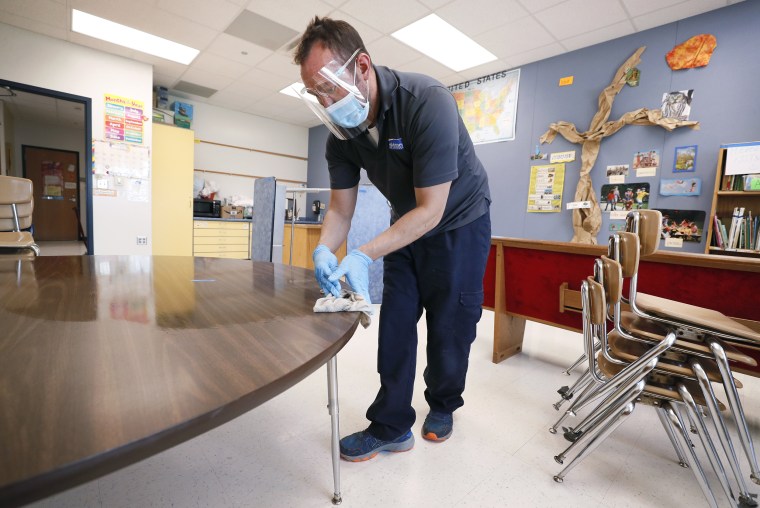The Centers for Disease Control and Prevention on Thursday released a long-awaited update to guidelines for getting children back into the classroom this fall, but it left many details of how to do so safely up to officials at the local level.
"Let the individual jurisdictions see how the different strategies that we've put out can be best employed," Dr. Robert Redfield, director of the CDC, said during a call with reporters Friday.
Full coverage of the coronavirus outbreak
There's no question that in-person learning is important to the growth and development of children. The question is how to do so safely.
"Children get much more than academics at school," members of the American Academy of Pediatrics, the American Federation of Teachers, the National Education Association and The School Superintendents Association wrote this month in a joint statement. "They also learn social and emotional skills at school, get healthy meals and exercise, mental health support and other services that cannot be easily replicated online."
The updated CDC guidance suggests schools can encourage physical distancing by expanding classrooms into unused buildings or moving instruction time outside, as well as keeping students in "pods" where the same groups stay together throughout the school day. The guidelines also encourage thorough hand-washing and regular disinfection of surfaces to cut the risk of COVID-19 spread.
The CDC also encourages schools to develop a plan of action if and when a student or teacher becomes ill, though the agency stopped short of offering suggestions on what such a plan might entail.
"We owe it to our nation's children to take personal responsibility to do everything we can to lower the level of COVID-19 so they can go back to school," Redfield said.
The nation's top infectious disease doctor, Dr. Anthony Fauci, said the CDC guidance is a "sound set of guidelines" and there is no "simple answer" when it comes to reopening schools.
"It depends on where you are," Fauci said Friday during an interview with The Washington Post that was streamed online. "We live in a very large country that is geographically and demographically diverse."
"If you live in a county or place where there's not much activity, send them back to school," he said.
Download the NBC News app for full coverage of the coronavirus outbreak
Also Friday, the journal Pediatrics published a survey of more than 1,000 parents that found the impact of keeping kids out of school has hit children and parents hard.
More than a quarter of parents reported a decline in mental well-being, and 14 percent said their children had exhibited behavioral problems.
"Parents across the country and kids across the country are in distress," said Dr. Stephen Patrick, the study's author and director of the Vanderbilt Center for Child Health Policy in Nashville, Tennessee.
The survey cited a variety of issues for families that extend beyond classroom instruction. A significant number of children rely on public schools for meals, internet access and health care.
Back-to-school risks?
It still remains unclear how easily kids are able to spread COVID-19.
One study from South Korean researchers found children over age 10 can transmit the virus just as well as adults. But, it appeared children under 10 might not spread it as easily.
"If you think about how the virus is spread through droplets, it makes sense given the fact that younger kids have smaller lung volumes and are less likely to expel as much air as quickly," said Dr. Nathaniel Beers, a pediatrician at Children's National Hospital in Washington. Beers was not involved with the South Korean study.
Dr. Deborah Birx, a member of the White House coronavirus task force, said the issue of how well younger children can spread COVID-19 is "still an open question."
"We certainly know from other studies that children under 10 do get infected. It's just unclear how rapidly they spread the virus," Birx said Friday on NBC's "TODAY" show.
Dr. Tom Inglesby, director of the Center for Health Security at the Johns Hopkins Bloomberg School of Public Health, wrote on Twitter Friday that "the administration and federal agencies do not need to spend time continuing to emphasize how valuable school is."
"What schools and families need is all the available info on kids' transmission risk to each other, teachers, families, and how to most lower those risks," he wrote.
At least 64 children have died of COVID-19 in the U.S., according to the CDC, and 342 have been diagnosed with a complication linked to the virus, multisystem inflammatory syndrome, or MIS-C.
Beers also expressed caution: "We need to be very judicious about reopening schools in areas where community spread of the virus is not contained."
Indeed, some school districts have already decided to provide online learning only, at least to start the school year.
Officials in San Diego and Los Angeles announced remote learning this fall, as well as districts in Nashville and Atlanta because of recent rises in COVID-19 cases.
Follow NBC HEALTH on Twitter & Facebook.

